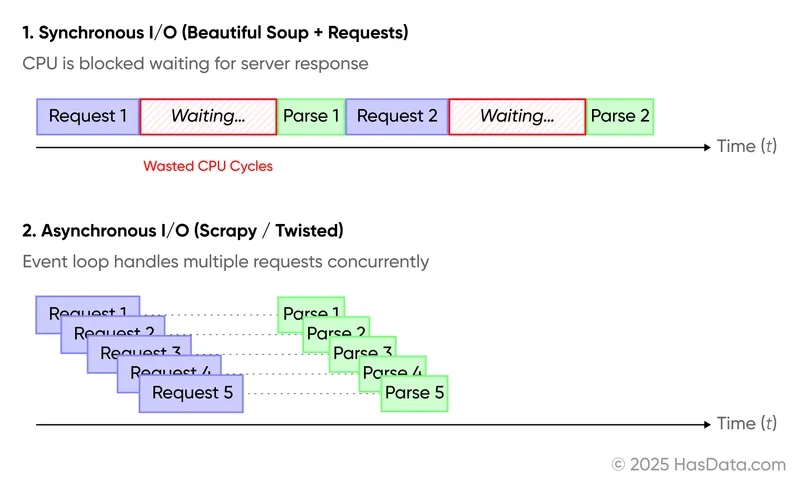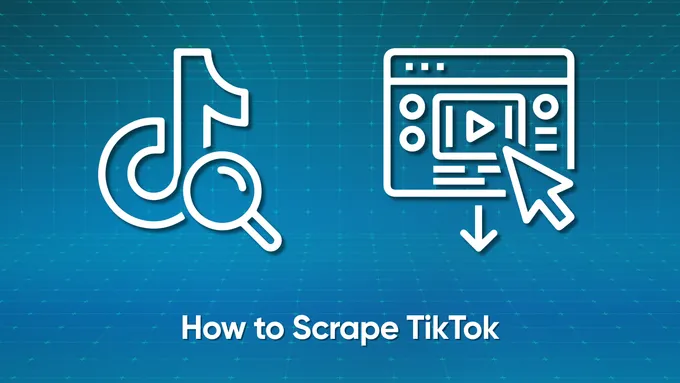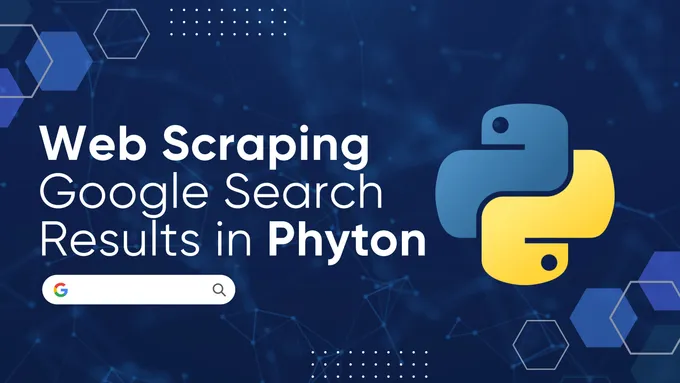Scrapy vs. Beautiful Soup: The 2025 Engineering Benchmark
For production use Scrapy. It is a full asynchronous framework built on Twisted. It handles concurrency, throttling, and retries out of the box. For learning use Beautiful Soup. It is a synchronous parsing library perfect for beginners or simple scripts.
In our tests, Scrapy outperformed standard Beautiful Soup scripts by 39x. Even heavily optimized BS4 scripts lag behind Scrapy’s ecosystem in maintainability.
The architectural difference between Scrapy and Beautiful Soup comes down to Asynchronous Event-Driven I/O versus Synchronous Blocking I/O.
Scrapy is a complete framework built on a non-blocking event loop for high-throughput crawling, while Beautiful Soup is a parsing library that relies on blocking HTTP clients like Python’s requests.
For production data pipelines involving more than 1,000 pages, Scrapy is the mathematically superior choice due to its non-blocking network engine. Beautiful Soup is the optimal choice for rapid prototyping, single-page extraction, or learning the DOM structure.
Here is the technical decision matrix based on performance, scalability, and maintenance costs:
| Feature | Beautiful Soup (bs4) | Scrapy |
|---|---|---|
| Core Architecture | Parsing Library (Requires requests or httpx) | Full Application Framework |
| I/O Model | Synchronous (Blocking) | Asynchronous (Non-blocking / Event Loop) |
| Concurrency | Manual (requires threading or asyncio) | Built-in (CONCURRENT_REQUESTS) |
| Throughput (10k pages) | Low (~1-2 pages/sec sequential) | High (~25-50+ pages/sec) |
| Memory Footprint | Low (Minimal overhead) | Medium (Requires reactor loop) |
| Error Handling | Manual (try/except blocks) | Built-in (Retry middleware, Auto-throttle) |
| Data Export | Manual (Write to file) | Built-in (Feed Exports to S3, GCS, JSON/CSV) |
| JS Rendering | None (Needs Selenium/Playwright) | Via Middleware scrapy-playwright or HasData) |
| Best For | Scripts, Prototyping, <100 pages. | ETL Pipelines, >10k pages, Data Products. |
The Event Loop vs. Blocking I/O
To understand why Scrapy smokes Beautiful Soup in performance, you have to look at how they handle the network layer.

Beautiful Soup
Beautiful Soup is not a crawler. It is a parser. It takes a messy HTML string and turns it into a Python object you can traverse. To get that HTML, you usually combine it with the requests library.
The Bottleneck: Python’s requests library is synchronous. When you request Page A, your script halts. It sits idle, waiting for the server to respond. Only after the data arrives does it parse, save, and move to Page B. Your CPU is bored 90% of the time waiting for network I/O.
Code Example (The “Requests + BS4” Stack):
import requests
from bs4 import BeautifulSoup
import time
import csv
URL = "https://quotes.toscrape.com"
RUNS = 1000
OUTPUT_FILE = "quotes_bs4_times.csv"
results = []
start_total = time.time()
for run_id in range(1, RUNS + 1):
request_start = time.time()
response = requests.get(URL) # The script BLOCKS here
request_end = time.time()
request_time = request_end - request_start
parse_start = time.time()
soup = BeautifulSoup(response.text, "html.parser")
quotes = soup.select(".quote .text")
parse_end = time.time()
parse_time = parse_end - parse_start
results.append({
"run_id": run_id,
"request_time": request_time,
"parse_time": parse_time,
"quotes_count": len(quotes)
})
with open(OUTPUT_FILE, "w", newline="", encoding="utf-8") as f:
writer = csv.DictWriter(f, fieldnames=["run_id", "request_time", "parse_time", "quotes_count"])
writer.writeheader()
writer.writerows(results)
end_total = time.time()
total_time = end_total - start_total
print(f"Saved results to {OUTPUT_FILE}")
print(f"Total script runtime: {total_time:.2f} seconds")Scrapy
Scrapy is a framework built on top of Twisted, an asynchronous networking engine. It uses a non-blocking event loop.
When Scrapy requests Page A, it fires the request and immediately moves on to request Page B, C, and D before Page A even responds. It can keep dozens (or hundreds) of requests in flight simultaneously.
Code Example (The Scrapy Spider):
import scrapy
import time
import csv
class QuotesSpider(scrapy.Spider):
name = "quotes_test"
allowed_domains = ["quotes.toscrape.com"]
start_urls = ["https://quotes.toscrape.com"]
custom_settings = {
# CSV output
"FEEDS": {
"quotes_times.csv": {"format": "csv", "overwrite": True},
}
}
def start_requests(self):
for i in range(1000): # 1000 runs
yield scrapy.Request(
url=self.start_urls[0],
callback=self.parse,
meta={'run_id': i+1, 'request_start': time.time()}
)
def parse(self, response):
request_start = response.meta['request_start']
request_end = time.time()
request_time = request_end - request_start
parse_start = time.time()
quotes = [q.css('.text::text').get() for q in response.css('.quote')]
parse_end = time.time()
parse_time = parse_end - parse_start
yield {
'run_id': response.meta['run_id'],
'request_time': request_time,
'parse_time': parse_time,
'quotes_count': len(quotes)
}Benchmark: Scrapy vs. BS4 (1,000 Pages)
We didn’t just want to talk about speed, we wanted to measure it. We ran a controlled test scraping the site quotes.toscrape.com 1,000 times.
The Setup:
- Environment: AWS EC2 t3.medium (2 vCPU, 4GB RAM)
- Target: 1,000 repeated requests to the same static HTML page.
- Delay: 0s (pure throughput test).
- Concurrency: 50 concurrent requests (where applicable).
- BS4 Setup: Standard
requestsloop +BeautifulSoup(features='html.parser') - Scrapy Optimization:
CONCURRENT_REQUESTS=50,DUPEFILTER_CLASS='scrapy.dupefilters.BaseDupeFilter'(to allow redundant URL crawling for the test).
The Results:
| Architecture | Stack | Time to Complete | Speed |
|---|---|---|---|
| Async Framework | Scrapy | 24.41s | ~41 pages/sec |
| Sync (Blocking) | BS4 + Requests | 954.29s (~16 min) | ~1 page/sec |
| Threaded | BS4 + ThreadPool | 120.63s (~2 min) | ~8.3 pages/sec |
| Custom Async | BS4 + aiohttp | 17.79s | ~56 pages/sec |
Using standard requests + bs4 is 39x slower than Scrapy. For a 100,000-page job, this is the difference between waiting 1 hour vs. 40 hours.
Adding Threading (concurrent.futures) improved speed significantly, but Scrapy was still 5x faster due to the efficiency of the Event Loop over OS-level context switching.
Don’t trust us? Here is the source code for the benchmark. Clone it and run it on your machine.
Wait, isn’t this an unfair comparison?
A senior engineer might look at this and say: “This comparison is unfair! You are comparing a synchronous library (requests) with an asynchronous framework. Of course Scrapy wins. You should compare Scrapy against Beautiful Soup + aiohttp.”
You are absolutely right. In fact, look at row #4 in our table.
When we wrote a custom script using BeautifulSoup + aiohttp + asyncio, it was actually faster than Scrapy (17.79s vs 24.41s) because it lacked the “middleware overhead” that Scrapy runs by default.
So why don’t we recommend BS4 + aiohttp for everyone?
Because maintenance costs matter. To get that performance with BS4, you have to:
- Manually manage the Event Loop (
asyncio). - Write your own Semaphore logic to limit concurrency (so you don’t DDOS the server).
- Write your own error handling and retry logic.
- Write your own data export (CSV/JSON) handlers.
Scrapy gives you 90% of that performance out of the box. You trade those 6 seconds of raw speed for hundreds of hours of saved development time. Scrapy is the “Batteries Included” solution. Custom Async is for when you want to build the batteries yourself.
JavaScript & Blocking
Here is where most tutorials lie to you. They show you code that works on quotes.toscrape.com, but fails on Amazon, LinkedIn, or any modern React/Vue application.
The Reality:
- JavaScript: Neither Scrapy nor Beautiful Soup can render JavaScript. If the data is loaded via AJAX or Hydration, both tools will see an empty page.
- Bans: If you fire Scrapy at full speed against a protected site, your IP will be banned in seconds. Scrapy sends a very distinct TLS fingerprint that anti-bot systems recognize immediately.
How to Fix This
To make either of these tools production-ready, you need to handle headless browsing and proxy rotation.
Option A: The “DIY” Hard Way
For Beautiful Soup, you have to wrap your script with Selenium or Playwright to get the HTML, then pass it to BS4.
For Scrapy, the official recommendation is now scrapy-playwright. It allows Scrapy to control a headless Chromium browser instance to render pages.
- Pros: Free (software-wise), high-quality rendering (better than the outdated Scrapy-Splash).
- Cons: Extremely heavy on RAM. Running 50 concurrent Scrapy requests is cheap. Running 50 concurrent Headless Chrome instances requires a massive server cluster.
Option B: The HasData Way (Middleware)
Managing a rotating proxy pool manually requires writing custom retry logic and complex middleware. In Scrapy, you can offload this complexity entirely to the middleware layer.
Instead of burning your own CPU/RAM, you can integrate HasData to handle proxy rotation and JS rendering. Since the API uses a POST request structure, we need to intercept the spider’s request and recreate it as an API payload.
1. Update settings.py. First, enable the middleware and configure your API key. Ensure your Scrapy concurrency matches your API plan limits to avoid throttling.
# settings.py
HASDATA_API_KEY = "YOUR_API_KEY"
DOWNLOADER_MIDDLEWARES = {
# Disable default UserAgent middleware if needed
'scrapy.downloadermiddlewares.useragent.UserAgentMiddleware': None,
# Enable our custom middleware
'myproject.middlewares.HasDataMiddleware': 543,
}
# IMPORTANT: Your concurrency must not exceed your HasData plan threads.
# If your plan allows 20 concurrent requests, set this to 20 or lower.
# Otherwise, you will receive 429 Too Many Requests errors.
CONCURRENT_REQUESTS = 20
2. Update your Spider. Add the API domain to your allowed list, otherwise Scrapy’s offsite filter will block the outgoing requests.
# spiders/quotes.py
class QuotesSpider(scrapy.Spider):
name = "quotes"
# Add the API domain here to prevent OffsiteMiddleware from blocking requests
allowed_domains = ["quotes.toscrape.com", "api.hasdata.com"]
start_urls = ["https://quotes.toscrape.com"]
# ...3. Create middlewares.py. Here is the production-ready code. It avoids infinite loops by tagging requests and properly reconstructing them for the API.
# middlewares.py
import json
from scrapy.http import Request
class HasDataMiddleware:
def process_request(self, request, spider):
# 1. Safety Check: Prevent Infinite Loops
# If the request is already tagged as an API request, let it pass through.
if request.meta.get('hasdata_api_request'):
return None
# 2. Retrieve setup
api_key = spider.settings.get('HASDATA_API_KEY')
# 3. Construct the API Payload
payload = {
"url": request.url,
"outputFormat": ["html"],
# "js_render": True, # <--- Uncomment for React/Vue sites
# "proxy_country": "US" # <--- Uncomment for geo-restricted data
}
# 4. Prepare Meta Data
new_meta = request.meta.copy()
new_meta.update({
'original_url': request.url, # Save original URL to restore it later
'hasdata_api_request': True, # Flag to prevent infinite loop
'dont_merge_cookies': True # Let the API handle cookies
})
# 5. Create a NEW Request object
# We do not modify the original request in place. We yield a new one.
new_request = Request(
url="https://api.hasdata.com/scrape/web",
method="POST",
headers={
'Content-Type': 'application/json',
'x-api-key': api_key
},
body=json.dumps(payload).encode('utf-8'),
meta=new_meta,
callback=request.callback, # Preserve original callback
errback=request.errback, # Preserve error handling
dont_filter=True # Allow duplicate requests (since URL is same API endpoint)
)
return new_request
def process_response(self, request, response, spider):
# 6. Restore the Original URL
# The spider expects the response to come from "quotes.toscrape.com",
# not "api.hasdata.com". We trick Scrapy by replacing the URL.
original_url = request.meta.get('original_url')
if original_url:
return response.replace(url=original_url)
return responseNow, Scrapy continues to work at high speed (asynchronous), but all complexity regarding Headless Chrome, Proxy Rotation, and TLS Fingerprinting is handled externally. You get clean HTML in your parse function as if the blocking didn’t exist.
Final Recommendations
Here is our heuristic for choosing the right tool:
Choose Beautiful Soup if:
- You are learning: The syntax is forgiving and great for understanding how the DOM works.
- The project is tiny: You need to scrape one table from Wikipedia for a data science project.
- You hate overhead: You don’t want to generate a project folder structure (
scrapy startproject) for a 50-line script.
Choose Scrapy if:
- Speed is critical: In our tests, Scrapy was 39x faster than the standard BS4 approach.
- You are building a product: You need reliability, built-in error handling (retries), and structured logging out of the box.
- The data is deep: You need to crawl Page 1 -> Link -> Detail Page -> Back. Scrapy’s
yield response.followmechanism is unbeatable here. - You value structured data: Scrapy forces you to separate logic (Spiders) from data structure (Items) and configuration (Settings), which prevents “spaghetti code.”
Using Beautiful Soup Inside Scrapy
A common misconception is that you must choose one or the other. This is false. Scrapy’s built-in selectors (XPath/CSS) are fast, but they are strict. If you are scraping old, malformed HTML (unclosed tags, nested tables from the 90s), Scrapy’s lxml-based selectors might fail to build the DOM correctly.
Beautiful Soup is slower but extremely forgiving. You can combine the best of both worlds: use Scrapy for the network layer (speed) and Beautiful Soup for the parsing layer (robustness).
import scrapy
from bs4 import BeautifulSoup
class BadHtmlSpider(scrapy.Spider):
name = "badhtml_bs4"
allowed_domains = ["badhtml.com"]
start_urls = ["https://badhtml.com/"]
def parse(self, response):
# Using BS4 for the parsing logic
soup = BeautifulSoup(response.text, "html.parser")
data = {}
# Leveraging BS4's Pythonic traversal
h1_tag = soup.find("article").find("h1") if soup.find("article") else None
data["H1"] = h1_tag.text.strip() if h1_tag else ""
article_links = []
article = soup.find("article")
if article:
for a in article.find_all("a"):
article_links.append({
"Link": a.get("href"),
"Text": a.get_text(strip=True)
})
data["Article Links"] = article_links
tips = []
tip_list = soup.find("ul", class_="tiplist")
if tip_list:
for li in tip_list.find_all("li"):
tips.append(li.get_text(strip=True))
data["Tips"] = tips
footer_links = []
footnotes = soup.find(id="footnotes")
if footnotes:
for a in footnotes.find_all("a"):
footer_links.append({
"Footer link": a.get("href"),
"Text": a.get_text(strip=True)
})
data["Footer Links"] = footer_links
yield dataYou sacrifice the memory efficiency of Scrapy (since BS4 loads the object tree), but you gain the parsing flexibility of Soup, while keeping the asynchronous speed of the Scrapy engine.
Happy Scraping.
Need to scrape complex JS-heavy sites at scale without maintaining a headless browser fleet? Try HasData for free. We handle the proxies, headless browsers, and CAPTCHAs so you can focus on the data.
FAQ
Can Scrapy bypass Cloudflare/recaptcha?
No, not natively. Scrapy is a lightweight HTTP client, not a browser. It cannot execute the JavaScript challenges, handle TLS fingerprinting, or solve CAPTCHAs required by modern WAFs. To bypass these protections, you need a middleware like HasData to handle browser emulation and rotation for you.
Is Scrapy faster than Selenium?
A: Yes, by orders of magnitude. Selenium loads a full web browser (GUI, CSS, Fonts, JS). Scrapy only downloads the raw HTML source code. Comparing them is like comparing a Ferrari (Scrapy) to a School Bus (Selenium). Use Scrapy for data, use Selenium/Playwright only when you absolutely need to render JS.
Which one is better for memory usage?
Scrapy is generally more memory efficient. Beautiful Soup creates a Python object for the entire DOM tree in memory upon loading. For a 10MB HTML file, BS4 can consume 50MB+ of RAM. Scrapy’s selectors allow you to extract data stream-wise without necessarily building the full object tree for the whole page.
Why does my Scrapy spider get banned faster than my BS4 script?
Because Scrapy is too fast. If you don’t configure DOWNLOAD_DELAY or AutoThrottle, Scrapy can hit a server with 50+ requests per second, triggering rate limiters instantly. BS4 scripts are usually slow enough to fly under the radar of basic rate limiters. To use Scrapy safely, you must intentionally slow it down or use a high-quality rotating proxy pool.


